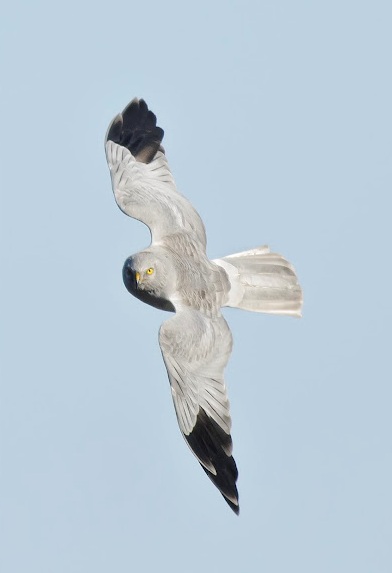21st December 2014. The longest night in the earth's history. Short days and low light levels meant Heather's satellite tag missed some scheduled transmissions - the first time this has happened really. Worrying. But like a ray of light, data comes in from the satellites in space to tell us Heather is alive and well. The data shows she is roosting back in her home range where she has spent the past few months in South Kerry. There is a good chance of seeing her leave her roost in the morning.
Through some of the most stunning scenery known to man, but invisible in the dark and fog, I travelled through the night to meet the local IHHWS volunteer, for whom Heather has highlighted two new roosts. In this weather and low visbility, the entire journey to one of the far reaches of South West Ireland could be in vein - would we see her at all? As always with Hen Harriers, it was worth the effort even just to say you were within a couple of hundred metres of these rare birds - anything after that was a bonus.
We assumed position. Pat on one side of the bog, his back to a fine big reek of turf; while I was at the other side of the bog, with a small herd of 7-8 cows for company. We waited eagerly. At 0831 I saw a flash of light on the far side of the bog - it was Pat's phone, calling to let me know Heather was in the air, flying towards me. I did not answer the phone as I already had her in my sights - the phone on silent, vibrating in my raincoat pocket. Closer and closer she came until she was within 40-50m. She looked fine and healthy. It was an absolute joy to see her in the flesh once again.
2014 was a very memorable year for Hen Harriers and all involved in their research and conservation in Ireland and indeed in Britain. From Galway to Dublin, Kerry to Antrim, Cork to Donegal, and everywhere in between, people have been striving towards finding out more about Hen Harriers in Ireland and people have been advocating strongly for their protection, and the protection of the habitat that they and so many other species depend on. This has been a personal highlight of 2014 - to see so many people become so independently minded on Hen Harriers in Ireland, progressing their own local studies and spreading the word on how wonderful a native Irish bird this is.
2015 will be difficult. Vested interests who want to remove the habitat of Hen Harriers (and Curlew, Red Grouse, Snipe, Skylark, Merlin, Meadow Pipit, Cuckoo...the list goes on and on) in favour of more "profitable" developments continue to lobby for such destruction. Sickeningly, these vested interests are trying to turn the custodians of the landscape who have managed the habitat for generations against conservation. The say "SPAs are stopping people living and farming" whereas there is in fact a clear solution - support farmers in the SPAs to live and farm and support the habitats and species (using the money the EU has provided for same). The SPAs would be seen as the most positive thing to ever grace these marginally productive lands, but instead because forestry is being touted as the only game in town, with large grants to get people to stop farming and plant their land, the SPAs are being seen as restrictive. What is more restrictive than planting the land of previous and future generations for the sake of a 15-20 year grant? Anyone who knows these areas can clearly see the decimation not only of landscape and wildlife, but of local communities, cultural and social heritage...and future.
There is no doubt but that the passion instilled in people's hearts who have seen these birds in their natural habitats will also come to the fore in 2015. In Britain they have serious issues with persecution and they have had marches and petitions with 10's of thousands of signatures in support of Hen Harriers. Here we have serious issues with habitat loss, which is arguably even more serious. If we lose what little habitat remains (natural/semi-natural habitat has now been lost from the vast majority of the Hen Harrier SPAs), and if we lose the farming people who manage these habitats, what hope would we ever have of holding our Hen Harrier population?
Thanks for all your input in 2014. We look forward together to a progressive 2015.
Have a wondeful Christmas.
Hen Harrier Ireland
@HarrierIreland














.jpg)




















